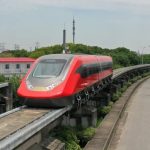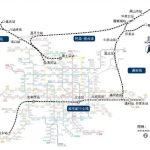- Transportation Numbers
- Passenger transportation.
The national railway passenger transport volume reached 2.533 billion, an increase of 366 million or 16.9% over the previous year; the national railway passenger turnover reached 955.909 billion passenger-km, an increase of 130.099 billion passenger-km or 15.8% over the previous year.
- Cargo freight.
The total volume of national railway freight transportation was 3.726 billion tons, an increase of 145 million tons or 4.0% over the previous year. Among them, the volume of container shipments increased by 23.5% over the previous year. The total turnover of national railway freight was 2,995.001 billion ton-km, an increase of 255.218 billion ton-km or 9.3% over the previous year.
- The total converted
The total converted turnover of national railways reached 3,950.91 billion ton-km, an increase of 385.317 billion ton-km or 10.8% over the previous year.
- Transport safety.
No particularly serious or major railway traffic accidents occurred throughout the year, and the number of deaths from railway traffic accidents decreased by 21.1% over the previous year.
- Railway construction
The national railway fixed asset investment was 748.9 billion yuan, and 4,208 kilometers of new lines were put into operation, including 2,168 kilometers of high-speed railways.
- The size of the railway
The national railway operating mileage is 150,000 kilometers, including 40,000 kilometers of high-speed railways; the national railway network density is 156.7 kilometers per 10,000 square kilometers; the double-track rate is 59.5%; the electrification rate is 73.3%. The railway operating mileage in the western region is 61,000 kilometers.
The national railway operating mileage is 131,000 kilometers, the double-track rate is 61.9%, and the electrification rate is 75.4%.
- Rolling stock.
21,700 units of railway locomotive, among them, 7,800 diesel locomotives, accounting for 35.9%; 13,900 electric locomotives, accounting for 64.1%. The national railway passenger car ownership is 78,000, including 4,153 trains of 33,221 cars. The national railway freight wagons ownership is 966,000.
- Energy saving and emission reduction
- Comprehensive energy consumption.
The national railway energy consumption converted into standard coal was 15.8074 million tons, an increase of 858,600 tons or 5.7% over the previous year. The comprehensive energy consumption per unit of transportation workload was 4.07 tons of standard coal/million ton-kilometers, a decrease of 0.16 tons of standard coal/million ton-kilometers, a decrease of 3.9% over the previous year. The main comprehensive energy consumption per unit of transportation workload was 4.02 tons of standard coal/million ton-kilometers, a decrease of 0.15 tons of standard coal/million ton-kilometers, a decrease of 3.5% over the previous year.
- The main pollutant emissions.
The national railway chemical oxygen demand emission was 1,611 tons, a decrease of 0.7% over the previous year. The emission of sulfur dioxide was 2,000 tons, a decrease of 29.0% over the previous year.
- Greening along the route.
The national railway greening mileage was 60,600 kilometers, an increase of 1,000 kilometers or 1.7% over the previous year.


